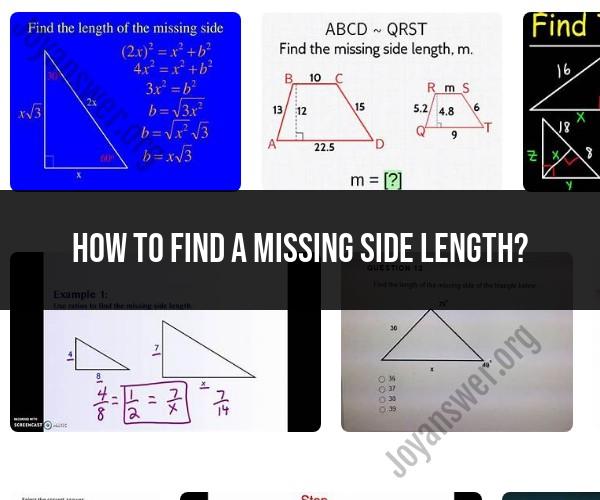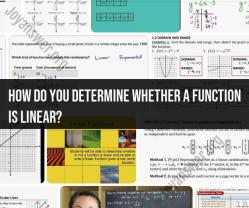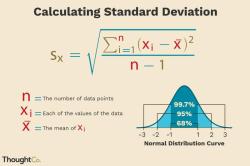How to find a missing side length?
Finding a missing side length in geometry involves applying various mathematical techniques depending on the shape and information provided. Here are some tips and techniques to help you find a missing side length:
1. Pythagorean Theorem (Right Triangles):
- If you have a right triangle and know the lengths of two sides (the legs), you can find the length of the third side (the hypotenuse) using the Pythagorean Theorem: a² + b² = c², where "a" and "b" are the lengths of the legs, and "c" is the length of the hypotenuse.
2. Special Right Triangles:
- In certain cases, like 30-60-90 or 45-45-90 triangles, you can find the missing side lengths using specific ratios of the known sides. For example, in a 30-60-90 triangle, the hypotenuse is twice as long as the short leg, and the longer leg is √3 times as long as the short leg.
3. Similar Triangles:
- If you have two similar triangles (meaning their angles are congruent), you can set up proportions to find missing side lengths. Ensure that corresponding sides are matched correctly.
4. Trigonometric Functions (Non-Right Triangles):
- In non-right triangles, you can use trigonometric functions like sine, cosine, and tangent to find missing side lengths. The Law of Sines and Law of Cosines are especially useful in such cases.
5. Perimeter and Area Formulas (Quadrilaterals):
- For quadrilaterals like rectangles, squares, and parallelograms, you can find missing side lengths using perimeter and area formulas. For instance, the perimeter of a rectangle is P = 2l + 2w, where "l" is the length and "w" is the width.
6. Coordinate Geometry:
- In coordinate geometry, you can use the distance formula to find the length between two points in a Cartesian plane. The distance formula is: d = √((x₂ - x₁)² + (y₂ - y₁)²), where (x₁, y₁) and (x₂, y₂) are the coordinates of the two points.
7. Algebraic Equations:
- Sometimes, you may need to set up algebraic equations based on given geometric relationships to find a missing side length. Solve the equation for the unknown side.
8. Similarity and Proportions:
- When dealing with similar polygons, you can use proportions to find missing side lengths. For example, if two triangles are similar, their corresponding sides are in proportion to each other.
9. 3D Geometry (Volume and Surface Area):
- In three-dimensional shapes like cubes, cylinders, and spheres, you may need to find missing side lengths to calculate volume or surface area. Use appropriate formulas for each shape.
10. Use Geometry Software:
- If you have access to geometry software or online calculators, you can input the given information and find the missing side length more quickly.
Remember to carefully read the problem statement, identify the type of shape you are dealing with, and use the appropriate technique to find the missing side length. Double-check your calculations to ensure accuracy, especially in complex geometric scenarios.
Finding Missing Side Lengths: Geometry Problem Solving
There are a number of techniques that can be used to find missing side lengths in geometry problems. Some of the most common techniques include:
- The Pythagorean Theorem: The Pythagorean Theorem states that in a right triangle, the square of the hypotenuse is equal to the sum of the squares of the other two sides. This can be used to solve for any missing side length in a right triangle.
- The Law of Cosines: The Law of Cosines states that in any triangle, the square of one side is equal to the sum of the squares of the other two sides minus twice the product of those sides and the cosine of the angle between them. This can be used to solve for any missing side length in any triangle.
- The Law of Sines: The Law of Sines states that in any triangle, the ratio of the sine of an angle to the length of the opposite side is equal to the ratio of the sine of another angle to the length of the opposite side. This can be used to solve for any missing side length in any triangle.
- Similarity: Two triangles are similar if they have the same angles. In similar triangles, the corresponding sides are proportional. This means that we can use the ratio of corresponding sides to solve for missing side lengths.
Geometry Puzzles: Discovering Unknown Side Lengths
Geometry puzzles are a great way to practice finding missing side lengths. Here is a simple example:
Problem:
In a right triangle, the hypotenuse is 10 cm and one leg is 6 cm. Find the length of the other leg.
Solution:
We can use the Pythagorean Theorem to solve for the missing side length:
a^2 + b^2 = c^2
Where:
- a is the length of the missing leg
- b is the length of the known leg (6 cm)
- c is the length of the hypotenuse (10 cm)
Substituting these values into the equation, we get:
a^2 + 6^2 = 10^2
Simplifying the equation, we get:
a^2 + 36 = 100
Subtracting 36 from both sides, we get:
a^2 = 64
Taking the square root of both sides, we get:
a = 8 cm
Therefore, the length of the missing leg is 8 cm.
Solving for Missing Sides: Geometry Techniques
Here are some additional tips for solving for missing side lengths in geometry problems:
- Identify the type of triangle. Is it a right triangle, isosceles triangle, equilateral triangle, or scalene triangle? Knowing the type of triangle will help you to choose the appropriate technique.
- Look for patterns. Are there any similar triangles in the problem? If so, you can use similarity to solve for the missing side lengths.
- Draw a diagram. Drawing a diagram can help you to visualize the problem and to identify the relationships between the different sides.
- Use algebra. Many geometry problems can be solved using basic algebra.
If you are stuck on a geometry problem, don't be afraid to ask for help. Your teacher, a tutor, or a friend can help you to understand the problem and to find the solution.











